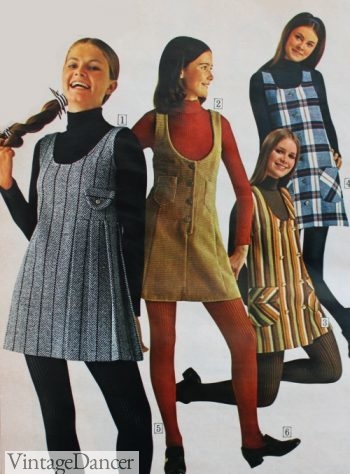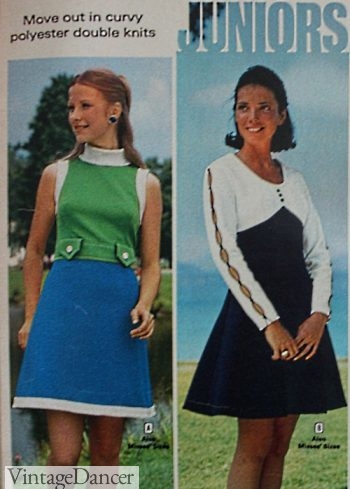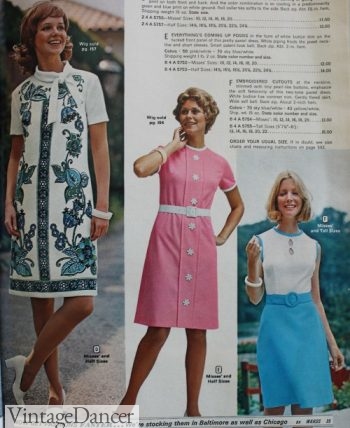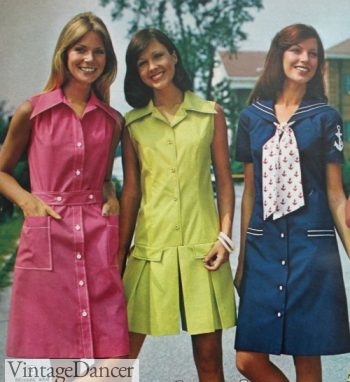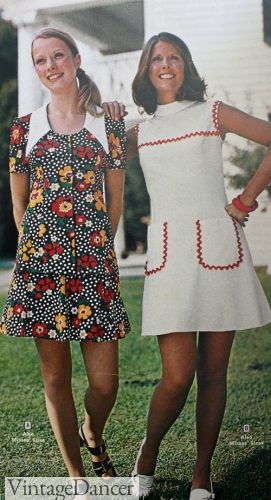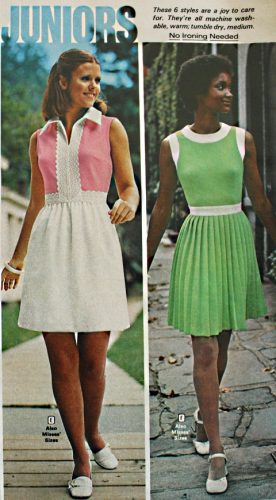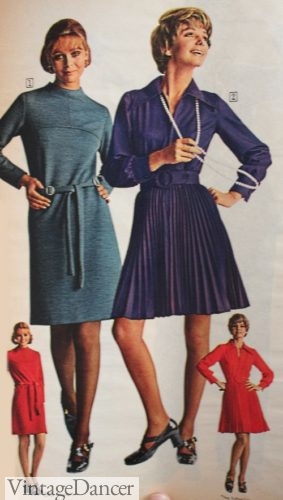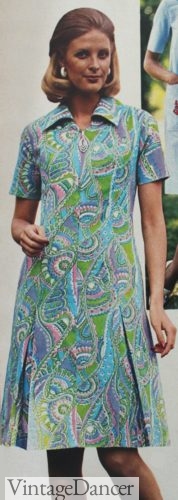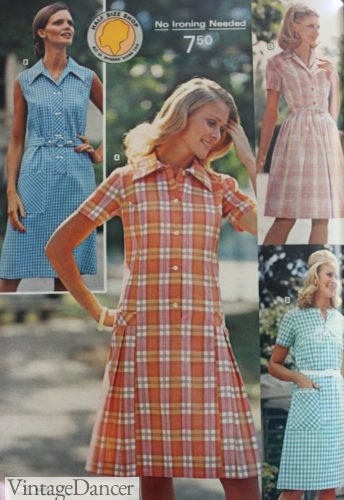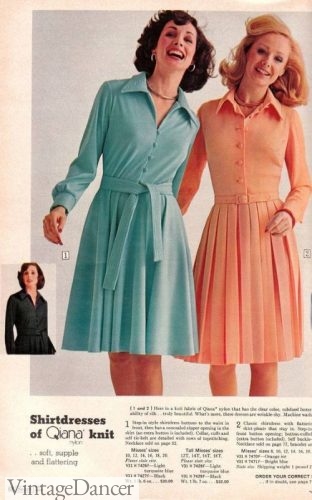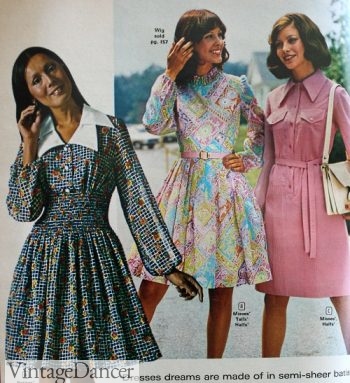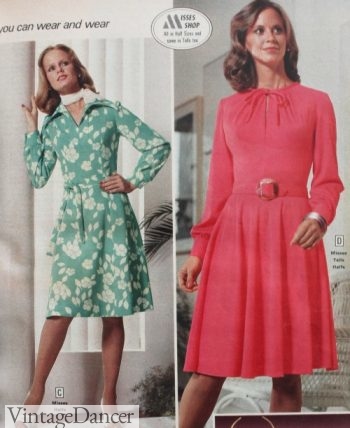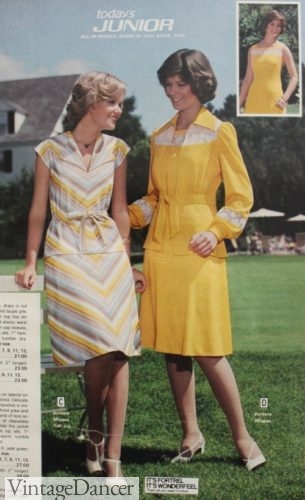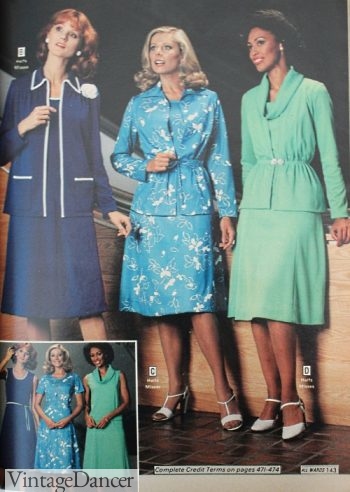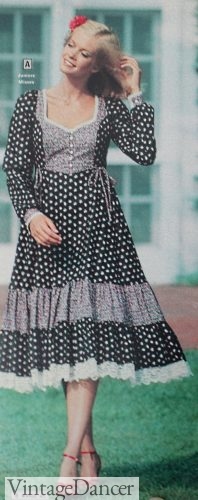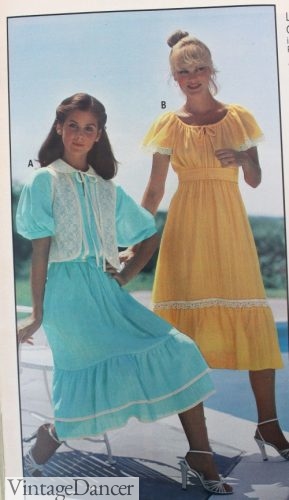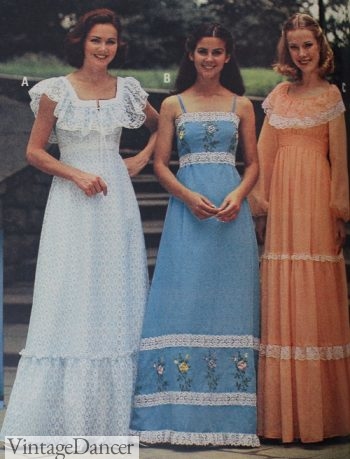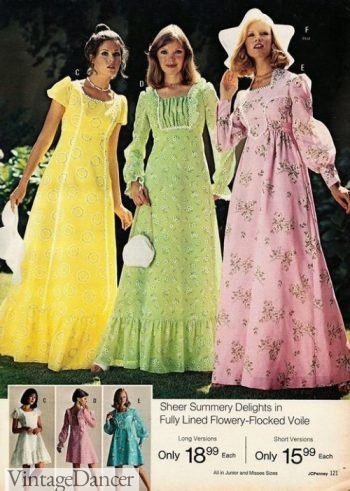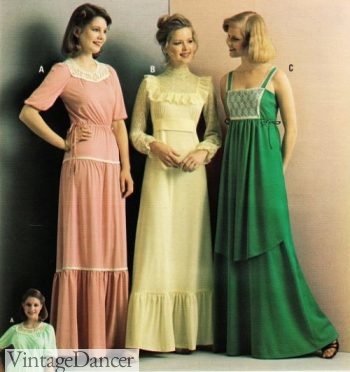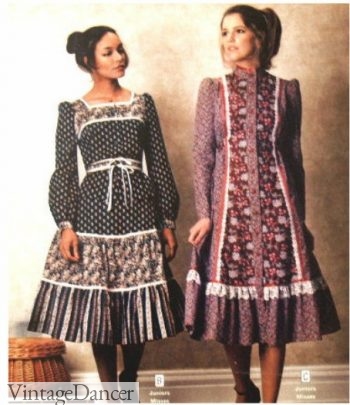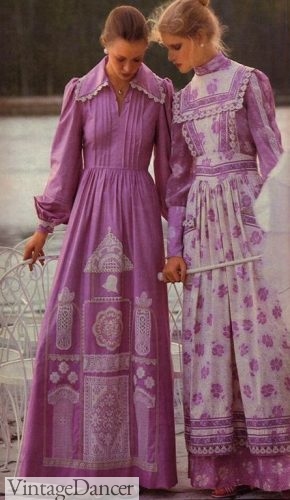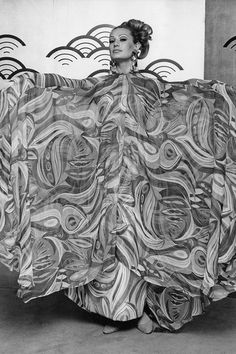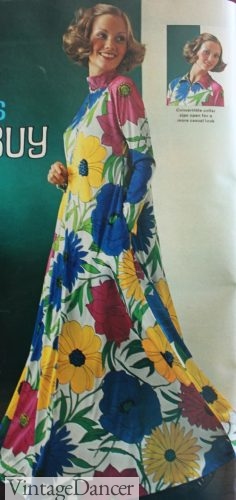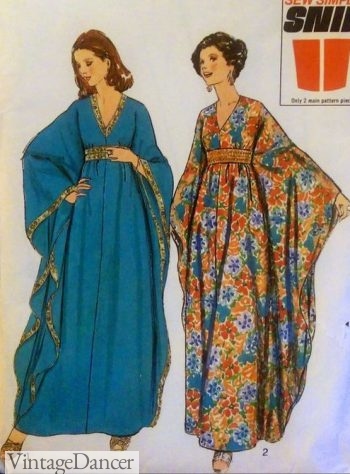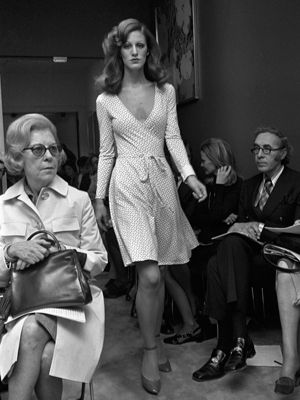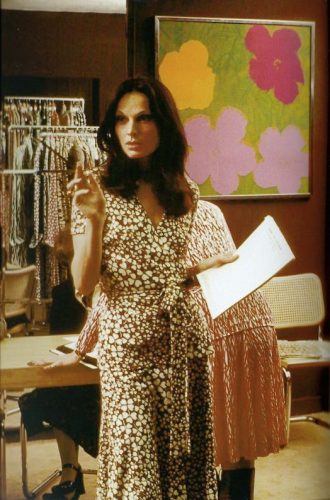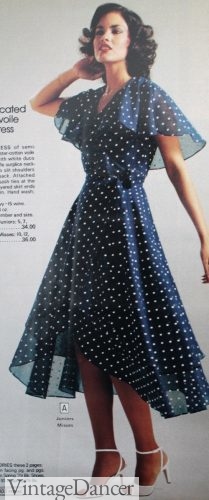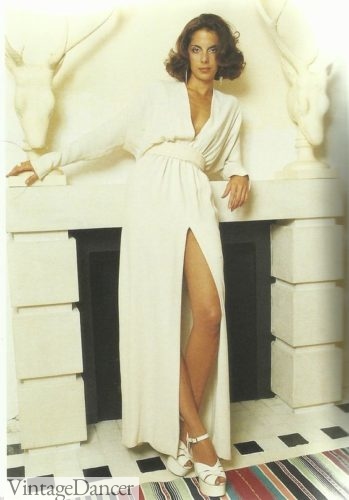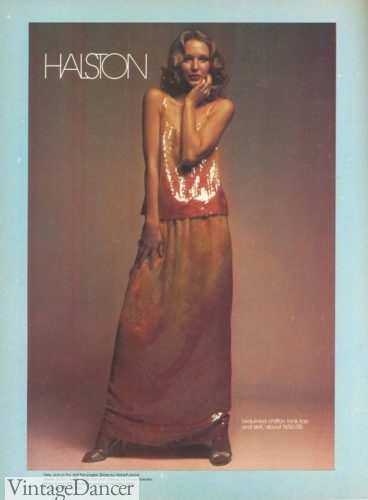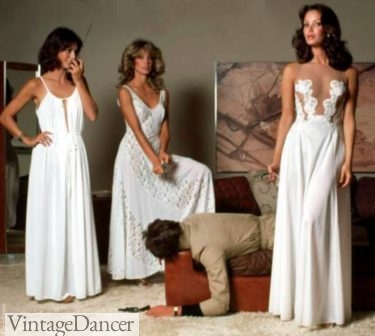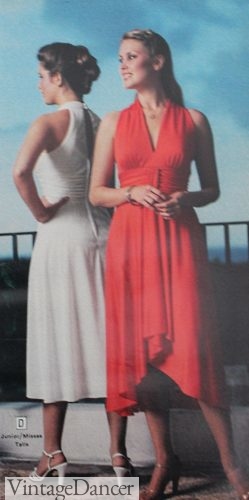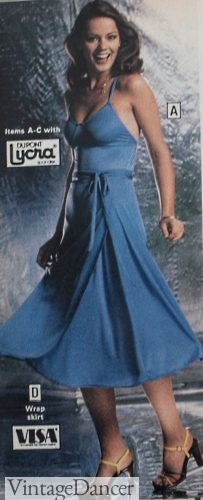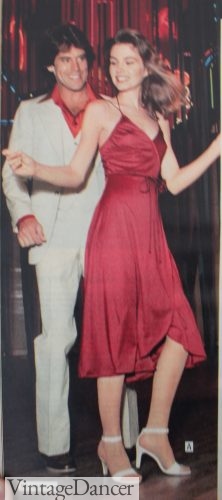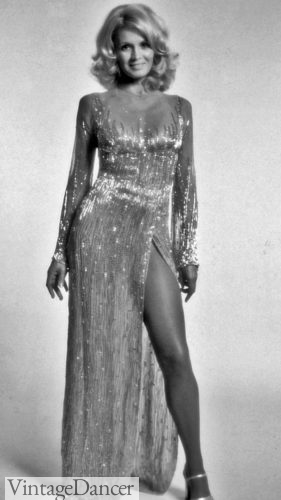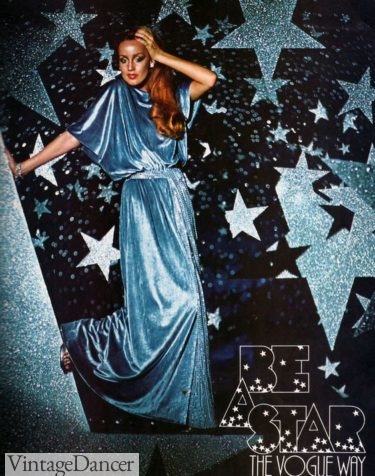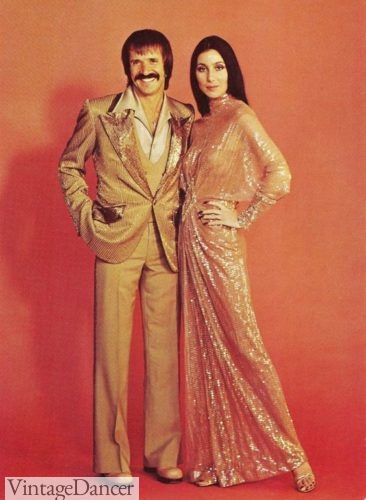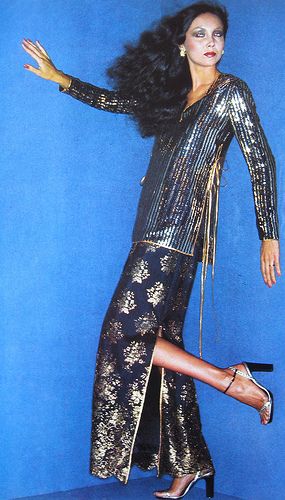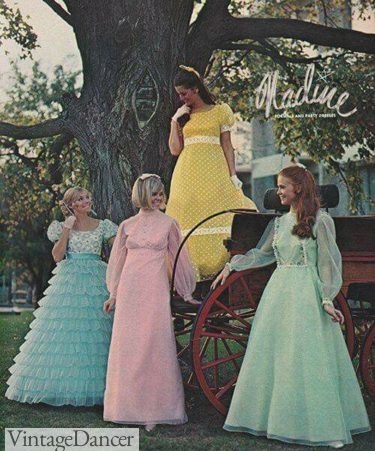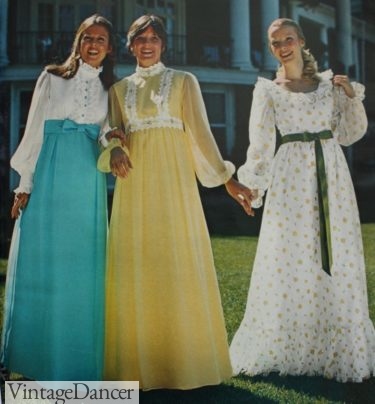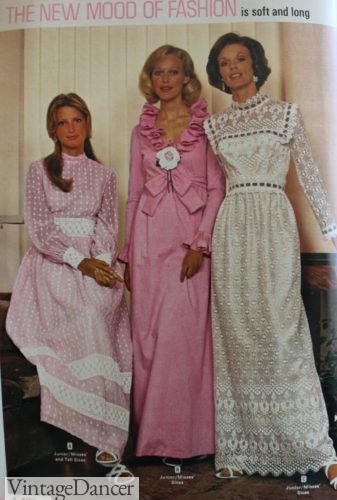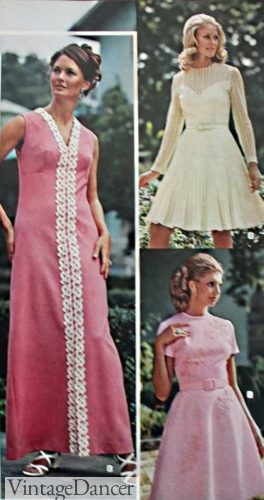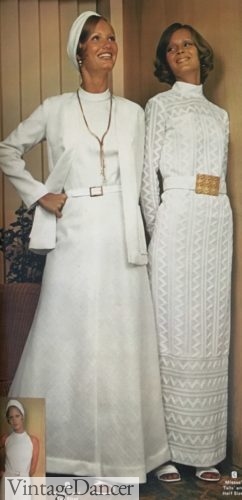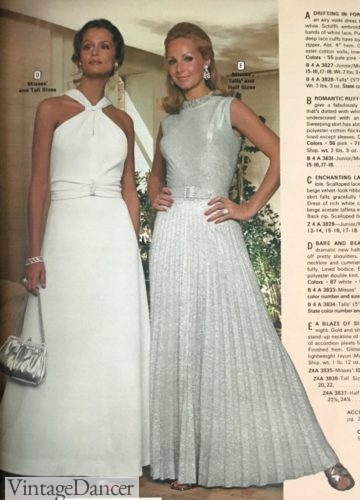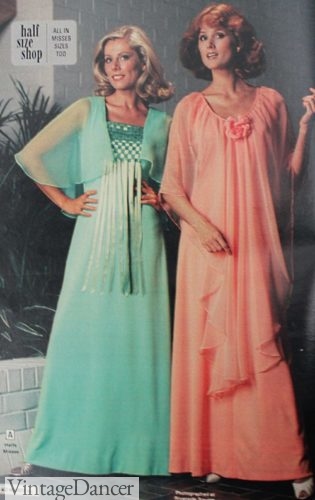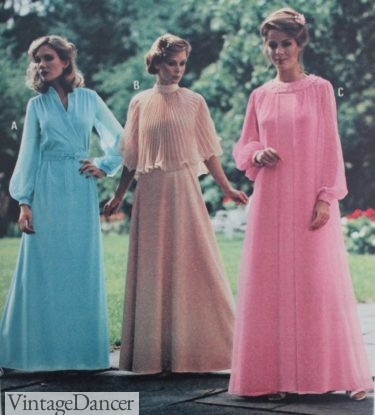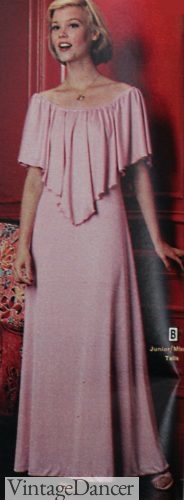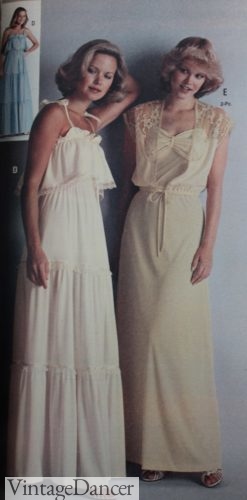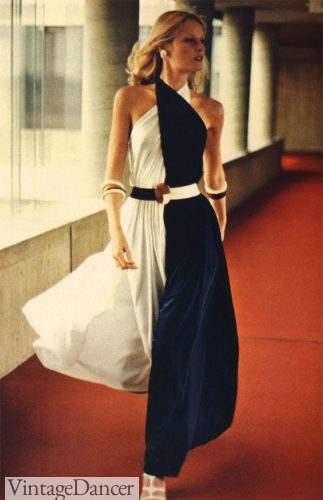There is no denying that ’70s fashion is back in style. Maxi dresses, hippie shirts, high waist jeans, boho jackets, and granny boots have all found their way into our closets again. With an entire decade of fashion to choose from, the late seventies / early eighties style is winning today’s vintage revival, especially when it comes to dresses.
Long 1970s dresses, peasant dresses, wrap dresses, and shirt dresses were popular dresses in the 1970s that are back in style now. Where did these designs come from? Let us explore the history of 1970s dress styles and find out.
You can skip the history and shop for 1970s style dresses here.
1970s Dresses
Were dresses popular in the 70s?
The 60s mini shift dress, jumper dress, drop waist dress, sheath dresses, and tunic dress were still hot items in the early ’70s. Sleeveless jumper dresses were worn over short or long sleeve shirts with high knee socks and tights to stay somewhat warm in winter. The mod style was still in vogue, too, with contrasting white collars and simple trims. Mod colors such as lime green, hot pink, orange, and red were summer classics. Pastels in spring and earth tones in fall/winter rounded out the collection.
- 1970 jumper dresses over turtleneck shirts
- 73 mod mini dresses
- 1973 shift dresses
Drop waist shift dresses and button front sheath dresses gave a nod back to the ’20s flapper era. This time, they were made of synthetic knits which opened the doors to light pastels, saturated earthy colors, textured tweeds, bright florals, and geometric prints. Polyester double knits and jacquard knit dresses were stiff enough to withstand wrinkles and staining. It was the perfect material for the age of low-maintenance practicality over comfort (poly knits are HOT!).
- 1973 shirtwaist, drop waist, sailor theme mini dresses
- 1973 mod dresses
- 70s white belts and collars
For women who were tired of freezing their legs off in the name of fashion, there were slightly longer knee-length dresses with high necklines and an A-line, pleated, or straight skirt. Many had oversized collars and some started to sport hippie prints in yellow, green, and orange flowers and paisley swirls. Many dresses in the early ’70s still featured mod colorblocking or solid colors with contrasting buttons. Vertical stripes, plaids, gigman checks, and polka dots were also favorite cotton house dress prints.
- 1970 simple short dresses- pleats or sheath
- 1973 paisley house dress
- 1973 plaid and gingham house dresses
By 1973, dresses were looking more like ’40s and ’50s swing dresses, with full skirts and button down blouse tops. With a button-down or zip up front, these classic dresses could be stepped into for quick dressing in the morning. A matching buckle belt, slide belt or tie belt nipped in the waist for an hourglass shape. The above-the-knee length made them easy to move in and a little bit sexy, as in the sexy housewife look frequently portrayed in ’70s movies.
- 1974 shirtwaist dress with tie belt in Quiana knit
- 1973 fit and flare dresses with large collars
The 40s style won the revival game for the remainder of the 70s. Simple one-piece dresses with a tie for a belt, cap sleeves and swingy skirt or the two piece tunic blouse worn over a matching skirt with a tie belt made up most 1970s casual dresses.
Many 70s dress styles included the button up shirtwaist style with long bishop sleeves and matching slide belt. Necklines were quite modest. Pussy bow neckties, small slits, mandarin collars, and large fold-out collars added variety to the modest dress tops.
- 1977 A-line dresses with belt or tie
- 1977 tunic dresses for teens
- 1978 two-piece tunic dresses with belts
In the final years, the drawstring neck and waistline along with a hemline that dropped a few inches below the knee loosened up dresses even more. The look was light, airy, and romantic without a hint of masculine tailoring. This is where the 70s boho dress fashion revival started.
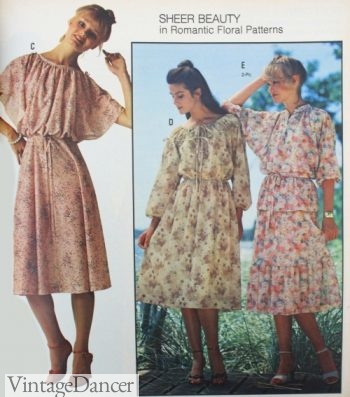
1978 sheer floral tie string waist dresses
70s Trendy Dresses
There were a few unique dresses made famous in the ’70s, although their influence was not always seen in the mainstream:
The granny dress or peasant dress was a mix of hippie meets Edwardian (post-Victorian era) modesty with a touch of folk art. Ralph Lauren developed the “Prarie” look in 1978 based on Victorian 1880s American dresses sold in Sears catalogs.
They were tea or ankle length maxi dresses (or skirts) in homey prints – calico, gingham checks, patchwork, denim, plaid, or tie-dyed for the day and velvet for evenings. They were trimmed in ruffles, lace, and embroidery.
The granny look was anti-plastic, anti-space age. Going back to the turn of the century was a nod to simpler, less risky times – perfect fashion for a new generation of peace-loving hippies.
- 1978 hippie peasant dress
- 1978 casual peasant dresses
- Long 1978 maxi dresses
The curator of those styles was Barbara Hulanicki’s “Biba” designs, which were picked up by American companies Gunne Sax and Arpeja. Millionsn of these Victorian-Edwardian dresses were sold. Dresses were topped with floral applique, corset-like laces, inset lace, and gathered sleeves.
Did they wear maxi dresses in the 70s?
Other names were the longette dress, maxi dress, milkmaid, and prairie dress. The popularity of the Little House on the Prairie TV series helped propel the designs into the mainstream. They were especially favored as prom, party, and eveningwear dresses when made up in solid pastel colors and white lace trim.
- 70s Victorian prairie dresses
- 70s maxi dresses
Lauren Ashley was another Victorian-inspired dress designer. Her floral cotton dresses with white high-necked blouses were priced affordably, which made them even more desirable.
Her line expanded to include pintuck blouses, leg o’mutton sleeve tops, lace trim, sashes, and floral print skirts that mimicked antique China patterns. She favored pinafore and smock top gowns and dresses with ruffled hemlines. Her designs looked rustic and homemade instead of high end.
- Gunne Sax peasant dresses
- Laura Ashley 70s granny dresses
Caftan dresses (or kaftan dresses) were the answer to every imperfect woman’s need for comfort. Made of printed cotton gauze, polyester prints, or smooth silk, they could be worn to the pool, a party, or dinner — but never to work or school.
Many caftans came in ethnic prints, large flowers, or vibrant psychedelic hand-painted motifs. Sophisticated caftans were Gracian inspired and worn with high heeled sandals and beads or pearls.
The caftan became a frequent style of hostess dress, especially in Hollywood, worn for in-home entertaining. Many singers also wore them as part of their on-stage persona.
- Wow! What a beautiful caftan dress
- 1973 flower hostess dress
- 1970s caftan or hostess dress pattern
The wrap dress designed by Diane von Furstenberg was a cotton jersey dress with a ballerina wrap top. While it took a few years to reach star status, the wrap dress, without buttons or zippers, became part of every woman’s wardrobe in the very late ’70s and well into the ’80s.
The 1970s wrap dress looked good on everybody and was packable, light, and comfortable. It was natural to wear it as a bedroom robe, yet so soft, and pretty women had to show them off in public.
In 1975 Furstenberg was making 15,000 wrap dresses a week for everyone from wealthy housewives to working professionals! It wasn’t until 1978 or 1979 that they were being reproduced on the mass market.
- DVF jersey wrap dress
- Diane Von Furstenberg wearing a wrap dress
- 1978 yellow ruffled wrap dress
- 1979 polka dot wrap dress
Roy Halston Frowick’s shirtwaist dress looked like a men’s long white dress shirt made of ultrasuede. Easy going, washable, and gender-bending, it sold 50,000 models. It was to become a heavy influence on ’80s power dresses. The shirtwaist dress was not a new design. It was seen throughout the ’70s, but it was Halston’s masculine design that turned this classic into something new.
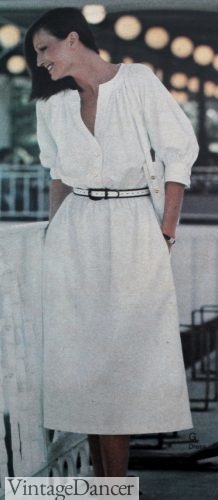
1978 white shirtwaist dress
As iconic as his shirtwaist dress, was it was Halston’s evening dresses and jumpsuits worn by famous celebrities that have made him the fashion designer of the ’70s.
Draped and bias cut dresses made of gold lamé, wraps of cashmere, and gathers in liquid jersey created a new evening look that was sexy, free, and easy. His looks were heavily inspired by Grecian evening gowns of the 1930s.
His fabrics were stretchy, making them ideal for the disco at Studio 54. “At night I think you want to be turned on, and there is nothing more of a turn-on than a fabric which hits the body the way the bias does.” (Palomo-Lovinski 49)
Other brands followed Halston’s evening designs, incorporating halter necks, glittering fabrics, and floating chiffons into formal gowns.
- Model Kitty Hawks wearing a Halston draped gown
- Halston metallic dress
- Charlie’s Angels in Halston Gowns
70s Disco Dresses
Going out to the disco meant putting on your favorite outfit, whether it be bell bottom jeans and a halterneck top or sparkling as brightly as the disco ball with a sequin dress. Disco dancing dresses included all of the above styles of 1970s dresses (except floor length), from casual or formal.
Some dresses were worn exclusively for the disco. The slip dress and wrap top slinky dress appeared at the end of the decade, inspired by ballet dance clothes. Formal dresses that sparkled from head to toe matched that of the disco ball. Metallic fabrics in gold or silver, all over sequin gowns, and shiny satins glittered all night long. Read more about ’70s disco fashion.
- 1979 party dresses
- 1979 Blue Disco Dress
- 1979 disco slip dress and heels
- Angie Dickinson wearing a sequin dress
- Vogue metallic evening dress
- Cher and Sonny – gold sequin dress
- 1976 Vogue sequin navy and gold tunic dress
Early ’70s formal dresses echoed the Victorian ball gown or Edwardian evening dress with an empire waist and full or column skirt. Mid to late ’70s formal dresses featured modest high necks, long full sleeves, empire waist, and pleated capes. They looked a lot like 1930s lingerie, nightgowns, and robes worn by Old Hollywood stars.
Pastels were the best colors for teens going to prom. White or pink was best for women’s eveningwear. In the later years, sea green, peach, coral teal, and baby blue made an evening affair a colorful and casual event.
- 1972 prom dresses
- 1973 prom or party prairie dresses
- 1973 bridesmaid dresses
- 1973 long and short evening dresses
- 1973 white evening dresses
- 1973 white and silver gowns
- 1978 chiffon evening gowns
- 1978 caped caftan gowns
- 1978 pink grecian gown
- 1978 summer party dresses
- Color lock draped evening gown 1972 – Irene Galitzine
Shop 1970s Dresses
Day to night, mini to maxi, house to disco. While you can still find vintage 70s dresses on etsy or eBay the cost of them is growing out of budget for many. We searched online for new 1970s dresses in all of the vintage styles mentioned above. If you need help finding the perfect 70s dress for you – just ask!
- Shop 1970s dresses– mini to maxi dresses, hippie to wrap dresses
- Shop 1970s plus size dresses – yes we found them!
- Shop 1970s evening dresses – Elegant gowns, prom, party, and cocktail dresses
- Shop 1970s prairie/peasant/maxi dresses
- Shop 1970s costumes – Disco dresses, hippie dresses for costume parties
- Need shoes to go with your dress? 1970s shoes
Debbie Sessions has been teaching fashion history and helping people dress for vintage themed events since 2009. She has turned a hobby into VintageDancer.com with hundreds of well researched articles and hand picked links to vintage inspired clothing online. She aims to make dressing accurately (or not) an affordable option for all. Oh, and she dances too.
